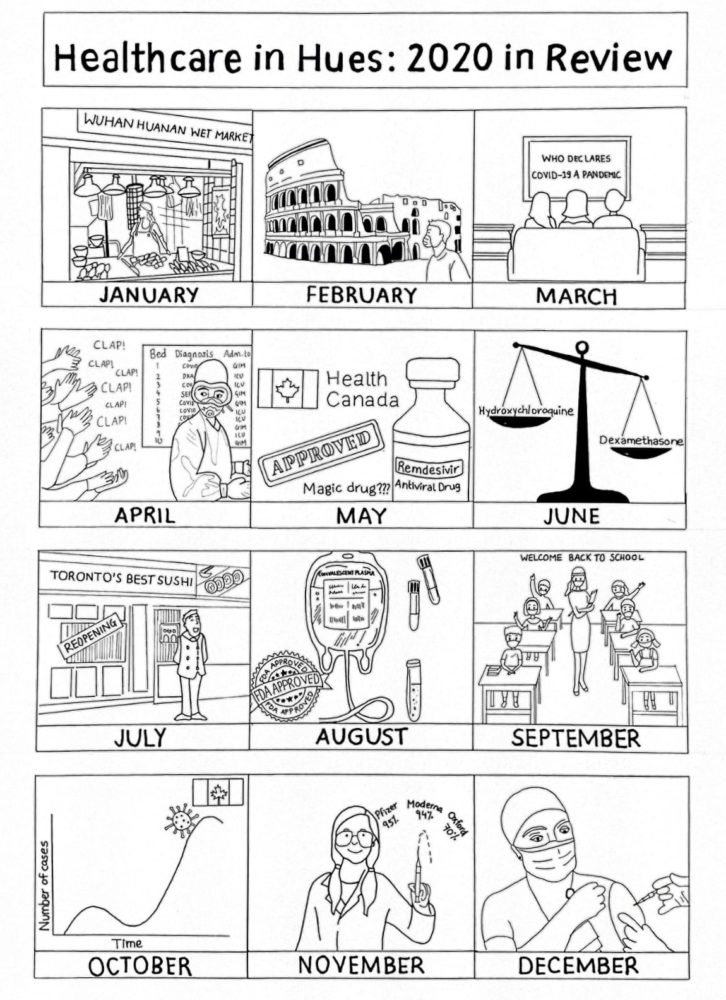The global response to the COVID-19 pandemic dominated 2020, a year marked by rising case counts and deaths and constantly evolving social, political and financial efforts to meet emerging public health information and regulations. In tandem came tremendous breakthroughs in telemedicine, delivery of patient care and large-scale efforts to understand and treat SARS-CoV-2. The year started with concerns that an outbreak from a “wet market” in Wuhan would spread to every corner of the world. And it did, with the disease burden continuing to increase internationally. We end 2020, however, with hope as impressive scientific advances have allowed the rapid production and dissemination of highly effective vaccines – and the opportunity to turn the page to an optimistic 2021.
This comic strip is the latest installment of Health Care in Hues, a monthly feature that explores the health-care system through art.
January |
The World Health Organization (WHO) announces the emergence of a mysterious coronavirus-related pneumonia, with the likely source a “wet market” in Wuhan, China. With increasing cases and several deaths within days, China takes an unprecedented step and closes off Wuhan and places surrounding regions under restricted-access protocols. |
February |
The WHO declares a global health emergency and coins the official name that will dominate headlines, COVID-19. As case counts continue to rise in China, other countries record their first cases. Italy rapidly emerges as the worst-hit country in Europe. |
March |
As the viral disease spreads globally, the WHO declares the COVID-19 outbreak a pandemic on March 11, with Europe as its epicentre. Canada joins many other countries in closing its borders. |
April |
Spontaneous public applauding for healthcare workers risking their lives to provide care takes place around the world. The United States surpasses Italy with the most confirmed COVID-related deaths and zooms past 1 million cases. Despite limited evidence supporting its efficacy and safety concerns over cardiac toxicity risks, hydroxychloroquine and chloroquine emerge as a possible treatment, spurred by U.S. President Donald Trump. |
May |
The Federal Drug Administration (FDA) approves remdesivir for emergency use based on preliminary National Institutes of Health (NIH) data. Health Canada follows suit. More evidence emerges showing hydroxychloroquine may be ineffective – and potentially harmful – in patients with COVID-19. |
June |
The U.S., India and Brazil rank among the top countries with COVID-19 cases. The FDA revokes emergency use authorization of hydroxychloroquine. Preliminary evidence that dexamethasone increases survival in patients requiring oxygen therapy or invasive ventilation emerges – a promising prospect for a highly available drug internationally. Remdesivir’s use continues to grow. The WHO issues new guidance encouraging the use of facemasks. |
July |
The majority of Ontario and other parts of Canada enter stage 3 of a three-stage re-opening strategy for businesses and public spaces. Hundreds of scientists pen an open letter to the WHO calling on the international body to revise recommendations for COVID-19 to reflect the risk of airborne transmission. The WHO follows up with a major announcement and new recommendations. |
August |
Convalescent plasma receives FDA approval for the treatment of COVID-19. As COVID-related deaths surpass 800,000 internationally, the search for effective therapies continues with international collaborative trials. Universities move toward re-opening, with the majority offering virtual classes. |
September |
COVID-related deaths cross 1 million internationally. Many Canadian provinces re-open schools with full-time, in-person classes. Multiple international trials supporting a survival benefit with dexamethasone are published, offering promise and widespread adoption with a strong recommendation from the WHO for severe and critical cases of COVID-19. |
October |
A second wave reaches Canada with an upsurge in COVID-related case counts and deaths. Global cases exceed 1 million cases over three days and now total more than 40 million. President Trump follows multiple members of the White House and contracts COVID-19, requiring hospitalization and making headlines internationally. |
November |
The worldwide case count tops 50 million as of Nov. 9. Pfizer, Moderna and AstraZeneca-Oxford emerge with large-scale trial evidence supporting high efficacy rates and optimal safety profiles for new vaccines – a light at the end of the tunnel. |
December |
As the year draws to a close and case counts and mortality rates continue to rise, rapid approval and distribution of the available vaccines gets underway. Long-term care facilities, followed by healthcare workers, are prioritized for the first iteration of vaccinations in most jurisdictions across Canada. |



The comments section is closed.